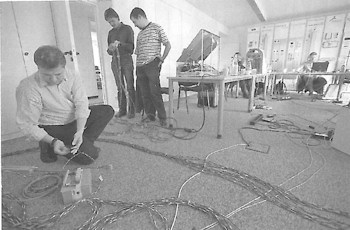CANopen Lift PlugFest - 2010-12: Difference between revisions
(article added 3rd plugfest) |
No edit summary |
||
| (4 intermediate revisions by 2 users not shown) | |||
| Line 1: | Line 1: | ||
'' | [[de:CANopen_Lift_Plugfest_-_2010-09-30]] | ||
'''3rd CANopen Lift plug fest''' | |||
[[File:3rd-plugfest.jpg|right]]In this CANopen Lift plug fest, CiA members performed several communication stress tests with their devices. The purpose of these devices are still capable to provide CANopen communication services without errors even at extreme bus conditions (up to full busload, up to maximal bus lenght). Both control device manufacturers (Boehnke + Partner and Weber Lifttechnik) as well as several suppliers of lift-unit makers (Elgo, Schaefer, Ziehl-Abegg, Control Techniques) connected their products to the CANopen network. During the one-day event, all busload tests were performed in tin and successfully. The tests have shown that the CANopen Lift devices were able to maintain error-free CANopen communication even at 100-% busload. The CANopen devices were connected during the tests to 230-m bus lenght at the default bitrate (250 kbit/s) defined in the CiA 417 application profile for lift control systems. | ''by HZ [http://www.can-cia.org/ CAN Newsletter] December 2010'' | ||
[[File:3rd-plugfest.jpg|right]]In this CANopen Lift plug fest, CiA members performed several communication stress tests with their devices. The purpose of these devices are still capable to provide CANopen communication services without errors even at extreme bus conditions (up to full busload, up to maximal bus lenght). Both control device manufacturers ([[Böhnke & Partner GmbH |Boehnke + Partner]] and [[Weber Lifttechnik GmbH|Weber Lifttechnik]]) as well as several suppliers of lift-unit makers ([[ELGO Electronic GmbH|Elgo]], [[SCHAEFER GmbH|Schaefer]], [[Ziehl-Abegg AG|Ziehl-Abegg]], [[Control Techniques GmbH|Control Techniques]]) connected their products to the CANopen network. During the one-day event, all busload tests were performed in tin and successfully. The tests have shown that the CANopen Lift devices were able to maintain error-free CANopen communication even at 100-% busload. The CANopen devices were connected during the tests to 230-m bus lenght at the default bitrate (250 kbit/s) defined in the [[The_CANopen_application_profile_for_lifts_CiA-417|CiA 417 application profile]] for lift control systems. | |||
The next CANopen Lift plug fest will take place in spring 2011. Then the new CiA 417 functions - being under development currently - may be tested. This includes measuring of power consumption and power-saving modes. | The next CANopen Lift plug fest will take place in spring 2011. Then the new CiA 417 functions - being under development currently - may be tested. This includes measuring of power consumption and power-saving modes. | ||
[[Category: Press]] | |||
[[Category: PlugFest]] | |||
[[Category: SIG Lift]] | |||
Latest revision as of 11:58, 18 September 2016
3rd CANopen Lift plug fest
by HZ CAN Newsletter December 2010

In this CANopen Lift plug fest, CiA members performed several communication stress tests with their devices. The purpose of these devices are still capable to provide CANopen communication services without errors even at extreme bus conditions (up to full busload, up to maximal bus lenght). Both control device manufacturers (Boehnke + Partner and Weber Lifttechnik) as well as several suppliers of lift-unit makers (Elgo, Schaefer, Ziehl-Abegg, Control Techniques) connected their products to the CANopen network. During the one-day event, all busload tests were performed in tin and successfully. The tests have shown that the CANopen Lift devices were able to maintain error-free CANopen communication even at 100-% busload. The CANopen devices were connected during the tests to 230-m bus lenght at the default bitrate (250 kbit/s) defined in the CiA 417 application profile for lift control systems.
The next CANopen Lift plug fest will take place in spring 2011. Then the new CiA 417 functions - being under development currently - may be tested. This includes measuring of power consumption and power-saving modes.